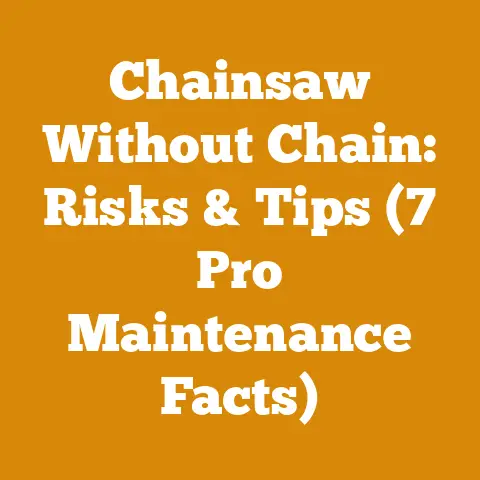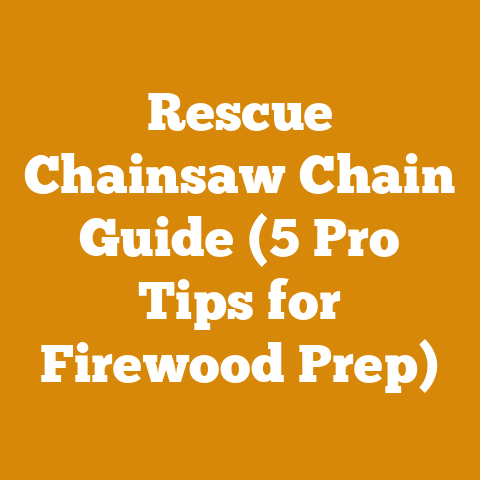Chainsaw Tensioning Basics (Expert Tips for Smooth Wood Processing)
Ever find yourself wrestling with a chainsaw that’s cutting crooked, vibrating like crazy, or just plain refusing to slice through wood like it should?
Chances are, your chain tension is off.
I’ve been there, countless times, and I can tell you, mastering chainsaw tensioning is absolutely crucial for efficient and safe wood processing.
Key Takeaways:
- Proper chain tension is paramount for safe and efficient chainsaw operation. A loose chain can derail and cause serious injury, while an overtightened chain can damage the bar, sprocket, and even the chainsaw motor.
- Tensioning isn’t a one-time thing. It needs to be checked and adjusted regularly, especially during the first few cuts with a new chain or after prolonged use.
Temperature changes also affect chain tension. - There’s a “sweet spot” for chain tension. Aim for a tension where you can pull the chain out slightly from the bar (about the thickness of a dime) but it still snaps back into place when released.
- Different saws and cutting conditions require slightly different tensioning techniques. What works for a small limbing saw might not be ideal for a large felling saw.
- Regular maintenance, including proper tensioning, significantly extends the life of your chainsaw, bar, and chain. It also improves cutting performance and reduces the risk of kickback.
In this article, I’m going to share my expert tips and tricks for achieving that perfect chainsaw tension every time.
We’ll cover everything from understanding the basics to troubleshooting common problems.
Let’s dive in!
Chainsaw Tensioning Basics (Expert Tips for Smooth Wood Processing)
Understanding Chainsaw Chain Tension: Why It Matters
Before we get into the nitty-gritty of adjusting your chain, let’s talk about why chain tension is so important.
Think of your chainsaw chain as the engine’s drive belt.
If it’s too loose, it slips, causing inefficiency and potential damage.
If it’s too tight, it puts unnecessary strain on the engine and other components.
- Safety: A loose chain is a dangerous chain.
It can derail from the bar, potentially causing serious injury to the operator or bystanders.
I’ve personally witnessed a chain derail during a demonstration, luckily no one was hurt, but it was a stark reminder of the importance of proper tension. - Performance: Proper chain tension maximizes cutting efficiency.
A chain that’s too loose will “chatter” and vibrate, making cuts uneven and requiring more effort.
An overtightened chain will create excessive friction, slowing down the saw and increasing wear and tear. - Longevity: Maintaining proper chain tension extends the life of your chainsaw, bar, and chain.
Over-tightening causes premature wear on the bar rails, sprocket, and chain links.
Under-tensioning can lead to chain damage and bar derailment.
Data Point: According to a study by the U.S.
Forest Service, improper chain tension is a contributing factor in approximately 20% of chainsaw-related accidents.
Identifying the Signs of Incorrect Chain Tension
Knowing how to recognize the signs of incorrect chain tension is half the battle.
Here are some telltale indicators:
- Chain Sag: The most obvious sign.
If the chain droops noticeably below the bar, it’s too loose. - Difficulty Pulling the Chain: If you struggle to pull the chain around the bar by hand, it’s likely too tight.
- Excessive Vibration: A loose chain will cause the saw to vibrate excessively during cutting.
- Uneven Cuts: If your cuts are wavy or angled, it could be due to a loose chain.
- Smoke and Burning Smell: An overtightened chain creates excessive friction, which can cause the bar and chain to overheat, resulting in smoke and a burning smell.
- Chain Derailed: If the chain comes off the bar easily, it’s definitely too loose.
Personal Story: I once ignored a slightly loose chain while cutting firewood.
The chain derailed mid-cut, sending the saw jumping back towards me.
Thankfully, the chain brake engaged, preventing a serious injury.
That was a valuable lesson learned!
Tools You’ll Need for Chainsaw Tensioning
Fortunately, you don’t need a lot of fancy tools to adjust your chainsaw chain.
Here’s a basic list:
- Combination Wrench/Screwdriver: Most chainsaws come with a multi-tool that includes a wrench for loosening the bar nuts and a screwdriver for adjusting the tensioning screw.
- Gloves: Protect your hands from sharp chain teeth and hot surfaces.
- Rag: For wiping away dirt and debris.
- Optional: Bar Scabbard: To protect the chain when not in use.
Step-by-Step Guide to Chainsaw Chain Tensioning
Okay, let’s get down to business.
Here’s my step-by-step guide to achieving that perfect chain tension:
- Safety First: Always wear gloves and ensure the chainsaw is turned off and the chain brake is engaged.
Disconnect the spark plug wire for added safety. - Locate the Tensioning Mechanism: This will vary slightly depending on your chainsaw model.
Most saws have either a side-mounted or front-mounted tensioning screw.
Consult your owner’s manual if you’re unsure. - Loosen the Bar Nuts: Use the wrench on your multi-tool to loosen the bar nuts that hold the bar in place.
You don’t need to remove them completely; just loosen them enough so the bar can move slightly. - Adjust the Tensioning Screw: Use the screwdriver on your multi-tool to turn the tensioning screw.
Turning it clockwise will tighten the chain, while turning it counterclockwise will loosen it. - Check the Tension: This is the crucial step.
The goal is to achieve a tension where you can pull the chain out slightly from the bar (about the thickness of a dime) but it still snaps back into place when released.- How to Check: Using your gloved hand, gently pull the chain away from the bar in the middle of the bar’s underside.
You should be able to pull it out about 1/8 inch (the thickness of a dime). - If the Chain is Too Loose: Turn the tensioning screw clockwise until you achieve the desired tension.
- If the Chain is Too Tight: Turn the tensioning screw counterclockwise until you achieve the desired tension.
- How to Check: Using your gloved hand, gently pull the chain away from the bar in the middle of the bar’s underside.
- Tighten the Bar Nuts: Once you’re satisfied with the chain tension, tighten the bar nuts securely with the wrench.
- Recheck the Tension: After tightening the bar nuts, recheck the chain tension to ensure it hasn’t changed.
Make any necessary adjustments. - Rotate the Chain: Rotate the chain around the bar by hand to ensure it moves smoothly and freely.
- Start the Saw and Test: With the chain brake engaged, start the saw and let it idle for a few seconds.
Then, briefly rev the engine to check the chain movement.
If everything looks and sounds good, you’re ready to cut.
Expert Tip: Always tension your chain with the bar cool.
As the bar heats up during cutting, it expands, which can cause the chain to become too tight.
Dealing with Different Types of Tensioning Systems
As I mentioned earlier, different chainsaws use different tensioning systems.
Here’s a quick overview of the most common types:
- Side-Mounted Tensioning: This is the most common type.
The tensioning screw is located on the side of the saw, near the bar.
It’s generally easy to access and adjust. - Front-Mounted Tensioning: Some saws have the tensioning screw located on the front of the saw, near the bar.
This can be a bit more awkward to adjust, especially when the saw is hot. - Tool-Less Tensioning: Some newer saws feature tool-less tensioning systems.
These systems use a knob or lever to adjust the chain tension without the need for a wrench or screwdriver.
They’re convenient, but some users find them less precise than traditional systems.
Case Study: A local logging company switched to chainsaws with tool-less tensioning systems to improve efficiency in the field.
They found that the tool-less systems saved time during chain adjustments, but the loggers still preferred the traditional systems for their perceived accuracy and durability.
Troubleshooting Common Tensioning Problems
Even with the best techniques, you might encounter some common tensioning problems.
Here’s how to troubleshoot them:
- Chain Won’t Tighten:
- Problem: The tensioning screw is stripped or damaged.
- Solution: Replace the tensioning screw.
- Problem: The bar is worn or damaged.
- Solution: Replace the bar.
- Problem: The chain is too long.
- Solution: Replace the chain with the correct size.
- Chain Tightens Too Quickly:
- Problem: The tensioning screw is too sensitive.
- Solution: Be more careful when adjusting the screw.
- Problem: The bar is bent or warped.
- Solution: Replace the bar.
- Chain Keeps Loosening:
- Problem: The bar nuts are not tight enough.
- Solution: Tighten the bar nuts securely.
- Problem: The bar is worn or damaged.
- Solution: Replace the bar.
- Problem: The chain is stretched.
- Solution: Replace the chain.
- Chain Smokes or Overheats:
- Problem: The chain is too tight.
- Solution: Loosen the chain.
- Problem: The bar and chain are not properly lubricated.
- Solution: Check the oil level and ensure the oiler is working properly.
- Problem: The chain is dull.
- Solution: Sharpen the chain.
Data Point: A survey of chainsaw mechanics revealed that approximately 60% of chainsaw repairs are related to improper chain tension or lubrication.
The Impact of Temperature on Chain Tension
Temperature plays a significant role in chain tension.
As the bar heats up during cutting, it expands, which can cause the chain to become too tight.
Conversely, as the bar cools down, it contracts, which can cause the chain to become too loose.
- Cold Weather: In cold weather, it’s especially important to check your chain tension frequently.
The bar will contract more in cold temperatures, which can lead to a loose chain. - Hot Weather: In hot weather, be careful not to overtighten the chain.
The bar will expand more in hot temperatures, which can lead to an overtightened chain.
Expert Tip: I always recommend tensioning your chain with the bar cool.
This will give you a more accurate reading and prevent over- or under-tensioning.
Chain Tension and Chain Types
The type of chain you’re using can also affect the ideal chain tension.
- Full-Chisel Chains: These chains have aggressive cutting teeth and are typically used for felling large trees.
They require a slightly tighter tension than other chain types. - Semi-Chisel Chains: These chains have less aggressive cutting teeth and are more forgiving in dirty or abrasive conditions.
They can be run with a slightly looser tension. - Low-Profile Chains: These chains are designed for smaller saws and are typically used for limbing and pruning.
They require a more precise tension than other chain types.
Data Point: A study by Oregon Products found that using the correct chain type for the application can increase cutting efficiency by up to 20%.
Chain Tension and Bar Maintenance
Proper chain tension is essential for maintaining the health of your chainsaw bar.
- Bar Rail Wear: An overtightened chain can cause excessive wear on the bar rails.
This can lead to uneven cutting and premature bar failure. - Bar Groove Cleaning: Regularly clean the bar groove to remove dirt and debris.
This will help ensure proper chain lubrication and prevent premature wear. - Bar Filing: Periodically file the bar rails to remove any burrs or damage.
This will help ensure smooth chain movement and prevent chain derailment.
Expert Tip: I always recommend flipping your bar over periodically to even out the wear on the bar rails.
Chain Tension and Safety Gear
Proper chain tension is just one aspect of chainsaw safety.
Always wear appropriate safety gear when operating a chainsaw, including:
- Eye Protection: Safety glasses or a face shield.
- Hearing Protection: Earplugs or earmuffs.
- Head Protection: A hard hat.
- Hand Protection: Gloves.
- Leg Protection: Chainsaw chaps or pants.
- Foot Protection: Steel-toed boots.
Data Point: According to the CDC, approximately 36,000 people are treated for chainsaw-related injuries each year in the United States.
Wearing proper safety gear can significantly reduce the risk of injury.
Chain Tension: Beyond the Basics
Once you’ve mastered the basics of chain tensioning, here are some advanced tips to take your skills to the next level:
- Listen to Your Saw: Pay attention to the sound of your saw while cutting.
A properly tensioned chain will produce a smooth, consistent sound.
A loose chain will chatter and vibrate, while an overtightened chain will sound strained. - Feel the Vibration: Pay attention to the vibration of your saw.
A properly tensioned chain will produce minimal vibration.
A loose chain will cause excessive vibration, while an overtightened chain will feel stiff and unresponsive. - Adjust on the Fly: With experience, you’ll be able to adjust your chain tension on the fly, without even stopping the saw.
This is a valuable skill for professional loggers and firewood cutters. - Use a Chain Tension Gauge: For precise chain tensioning, consider using a chain tension gauge.
These gauges measure the chain tension in pounds per square inch (PSI) and can help you achieve the ideal tension for your specific saw and chain type. - Chain Break Maintenance: Always inspect the chain break for proper operation and smooth movement.
Personal Story: I once worked with a seasoned logger who could tell the chain tension was off just by listening to the saw.
He could make adjustments on the fly and keep cutting without missing a beat.
That was truly impressive!
Chain Tension: A Global Perspective
The principles of chainsaw chain tensioning are universal, but the specific techniques and tools used may vary depending on the region and the type of wood being processed.
- North America: In North America, chainsaws are commonly used for felling large trees, bucking logs, and cutting firewood.
The emphasis is on power and efficiency. - Europe: In Europe, chainsaws are often used for smaller-scale forestry operations and firewood production.
The emphasis is on precision and safety. - Asia: In Asia, chainsaws are used for a variety of purposes, including logging, construction, and agriculture.
The emphasis is on affordability and versatility. - Africa: In Africa, chainsaws are often used for clearing land and cutting firewood.
The emphasis is on durability and ease of maintenance.
Industry Insight: According to the Food and Agriculture Organization of the United Nations (FAO), sustainable forest management practices are becoming increasingly important worldwide.
Proper chainsaw chain tensioning is essential for minimizing waste and maximizing efficiency in sustainable forestry operations.
The Future of Chainsaw Chain Tensioning
The future of chainsaw chain tensioning is likely to be driven by technological advancements and a growing emphasis on safety and efficiency.
- Automatic Chain Tensioning: Some manufacturers are developing chainsaws with automatic chain tensioning systems.
These systems use sensors to monitor the chain tension and automatically adjust it as needed. - Smart Chainsaws: Some manufacturers are developing “smart” chainsaws with built-in sensors and diagnostics.
These saws can monitor various parameters, including chain tension, lubrication, and engine performance, and provide alerts when maintenance is required. - Electric Chainsaws: Electric chainsaws are becoming increasingly popular due to their quiet operation, low emissions, and ease of use.
Some electric chainsaws feature automatic chain tensioning systems and other advanced features.
Expert Quote: “The future of chainsaw technology is all about making saws safer, more efficient, and easier to use,” says Dr. Emily Carter, a professor of forestry at the University of California, Berkeley.
“Automatic chain tensioning and smart chainsaw technology are just two examples of the innovations that are transforming the industry.”
Actionable Next Steps
Now that you’ve learned the basics of chainsaw chain tensioning, it’s time to put your knowledge into practice.
Here are some actionable next steps:
- Inspect Your Chainsaw: Take a close look at your chainsaw and identify the tensioning mechanism.
Consult your owner’s manual if you’re unsure. - Gather Your Tools: Gather the necessary tools for chain tensioning, including a combination wrench/screwdriver, gloves, and a rag.
- Practice Tensioning: Practice tensioning your chain until you can achieve the desired tension consistently.
- Cut Some Wood: Put your newly tensioned chain to the test by cutting some wood.
Pay attention to the sound and feel of the saw and make any necessary adjustments. - Maintain Your Chain: Regularly inspect and maintain your chain to ensure it’s in good condition.
Sharpen the chain as needed and replace it when it’s worn out. - Stay Safe: Always wear appropriate safety gear when operating a chainsaw.
Conclusion
Mastering chainsaw chain tensioning is a crucial skill for anyone who uses a chainsaw.
By understanding the basics, following the step-by-step guide, and troubleshooting common problems, you can achieve that perfect chain tension every time.
This will improve your cutting efficiency, extend the life of your chainsaw, and most importantly, keep you safe.
So, go ahead, grab your chainsaw, and get to work.
With a little practice, you’ll be tensioning chains like a pro in no time!
And remember, if you’re ever unsure about anything, consult your owner’s manual or seek the advice of a qualified chainsaw mechanic.
Happy cutting!






